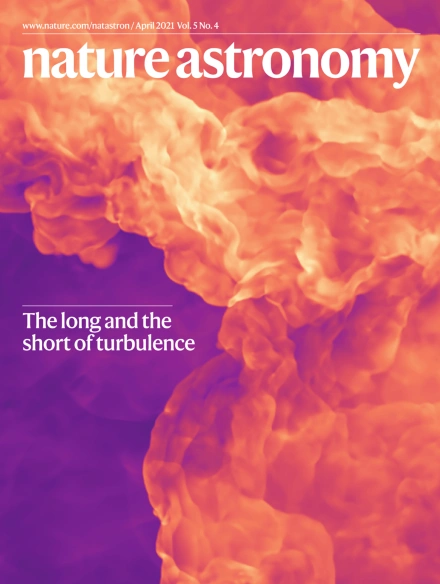
Contact Info
Australian National University
christoph.federrath@anu.edu.au
+61 (0)2 6125 0217
0000-0002-0706-2306
GitHub Bitbucket

Nature Astronomy, cover, April 2021.
https://spaceaustralia.com/news/stellar-simulation-reveals-turbulent-nature-star-birth
https://astro3d.org.au/simulating-gas-turbulence/
https://cosmosmagazine.com/space/astrophysics/star-making-motion
https://www.uni-heidelberg.de/en/newsroom/the-role-of-turbulence-in-the-birth-of-stars
https://www.anu.edu.au/news/all-news/study-helps-unlock-secrets-of-star-formation
Understanding the physics of turbulence is crucial for many applications, including weather, industry and astrophysics. In the interstellar medium, supersonic turbulence plays a crucial role in controlling the gas density and velocity structure, and ultimately the birth of stars. Here we present a simulation of interstellar turbulence with a grid resolution of 10,048^3 cells that allows us to determine the position and width of the sonic scale (l_s) - the transition from supersonic to subsonic turbulence. The simulation simultaneously resolves the supersonic and subsonic cascade, with the velocity as a function of scale, v(l) ~ l^p, where we measure p_sup = 0.49 +/- 0.01 and p_sub = 0.39 +/- 0.02, respectively. We find that l_s agrees with the relation l_s = phi_s L Mach^(-1/p_sup), where Mach is the three-dimensional Mach number, L is either the driving scale of the turbulence or the diameter of a molecular cloud, and phi_s is a dimensionless factor of order unity. If L is the driving scale, we measure phi_s = 0.42 (+0.12)(-0.09), primarily because of the separation between the driving scale and the start of the supersonic cascade. For a supersonic cascade extending beyond the cloud scale, we get phi_s = 0.91 (+0.25)(-0.20). In both cases, phi_s <~ 1, because we find that the supersonic cascade transitions smoothly to the subsonic cascade over a factor of 3 in scale, instead of a sharp transition. Our measurements provide quantitative input for turbulence-regulated models of filament structure and star formation in molecular clouds.
[ Federrath_sonic_scale_lowres.mp4, 103MB mid-res mpeg 4 video ] [ Federrath_sonic_scale.mp4, 204MB high-res mpeg 4 video ]
C.F. acknowledges funding provided by the Australian Research Council (Discovery Project DP170100603 and Future Fellowship FT180100495), and the Australia-Germany Joint Research Cooperation Scheme (UA-DAAD). C.F. further acknowledges the Australian Research Council Centre of Excellence for All Sky Astrophysics in 3 Dimensions (ASTRO 3D), through project number CE170100013. R.S.K. acknowledges support from the German Research Foundation (DFG) via the collaborative research center 'The Milky Way System' (SFB 881, Project-ID 138713538, subprojects A1, B1, B2, and B8) as well as support from the Heidelberg cluster of excellence EXC 2181 (Project-ID 390900948) 'STRUCTURES: A unifying approach to emergent phenomena in the physical world, mathematics, and complex data' funded by the German Excellence Strategy. He also thanks the European Research Council for support via the ERC Advanced Grant 'STARLIGHT' (project ID 339177) and the ERC Synergy Grant 'ECOGAL' (project ID 855130). We further acknowledge high-performance computing resources provided by the Leibniz Rechenzentrum and the Gauss Centre for Supercomputing (grants pr32lo, pr48pi and GCS Large-scale project 10391), the Australian National Computational Infrastructure (grant ek9) in the framework of the National Computational Merit Allocation Scheme and the ANU Merit Allocation Scheme. The simulation software FLASH was in part developed by the DOE-supported Flash Center for Computational Science at the University of Chicago.